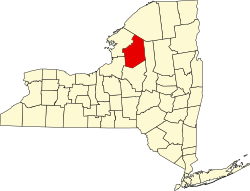This article has multiple issues. Please help improve it or discuss these issues on the talk page . (Learn how and when to remove these messages)
|
Lewis County | |
|---|---|
 | |
 Location within the U.S. state of New York | |
 New York's location within the U.S. | |
| Coordinates: 43°47′N75°27′W / 43.79°N 75.45°W | |
| Country | |
| State | |
| Founded | 1805 |
| Named after | Morgan Lewis |
| Seat | Lowville |
| Largest village | Lowville |
| Area | |
• Total | 1,290 sq mi (3,300 km2) |
| • Land | 1,275 sq mi (3,300 km2) |
| • Water | 15 sq mi (39 km2) 1.2% |
| Population (2020) | |
• Total | 26,582 [1] |
| • Density | 20.8/sq mi (8.0/km2) |
| Time zone | UTC−5 (Eastern) |
| • Summer (DST) | UTC−4 (EDT) |
| Congressional district | 21st |
| Website | www |
Lewis County is a county located in the northwestern part of the U.S. state of New York, situated between the Adirondack Mountains and the Tug Hill Plateau, within the state's North Country region. As of the 2020 census, the county had a population of 26,582, making it the fourth-least populous county in New York. Its county seat is Lowville. Named after Morgan Lewis, Governor of New York at the time of its establishment in 1805, Lewis County was formed from part of Oneida County and has undergone multiple jurisdictional changes since the colonial era. The county is part of the North Country region of the state.
Contents
- History
- Jurisdiction history
- Military history
- Geography
- Adjacent counties
- Transportation
- Demographics
- 2020 census
- 2000 census
- Communities
- Larger Settlements
- Towns
- Hamlets
- Notable people
- Politics
- Education
- See also
- Bibliography
- References
- Further reading
- External links
The area was originally inhabited by the Iroquois Confederacy before being incorporated into colonial and later state holdings following the American Revolutionary War. Settlement expanded in the late 18th century after Macomb's Purchase, and the county has historical significance related to early militia formations and its role in the War of 1812.
Geographically, the county includes portions of Adirondack Park, the Black River Valley, and is part of New York’s Snowbelt, receiving some of the highest snowfall totals in the eastern United States. Its economy is primarily based on agriculture, forestry, and renewable energy, with growing contributions from tourism and winter recreation.
Demographically, the population is predominantly White, with a rural character and low population density. Politically, Lewis County has a long-standing pattern of supporting Republican candidates, with only a few deviations since the Civil War. The county is home to several small towns and villages, including Copenhagen, Croghan, and Lyons Falls, and hosts one of the oldest agricultural fairs in the state, the Lewis County Fair.


